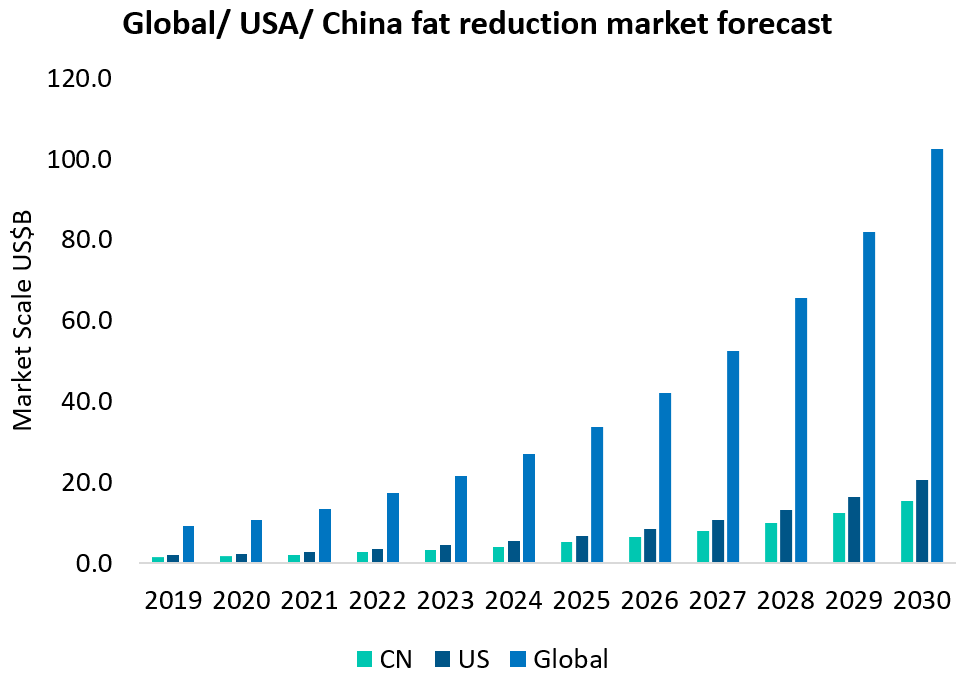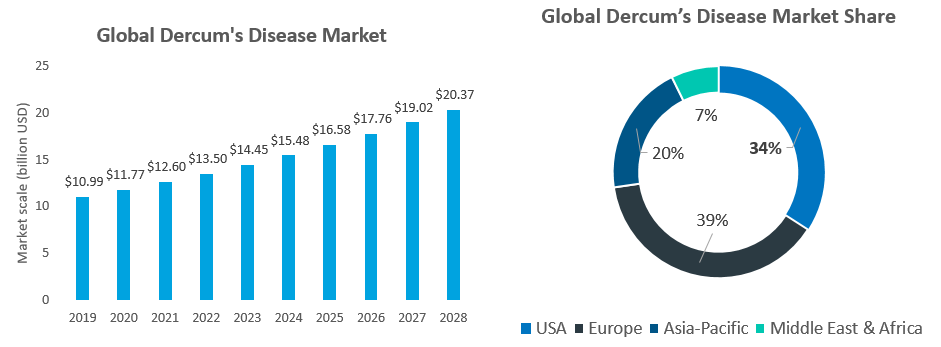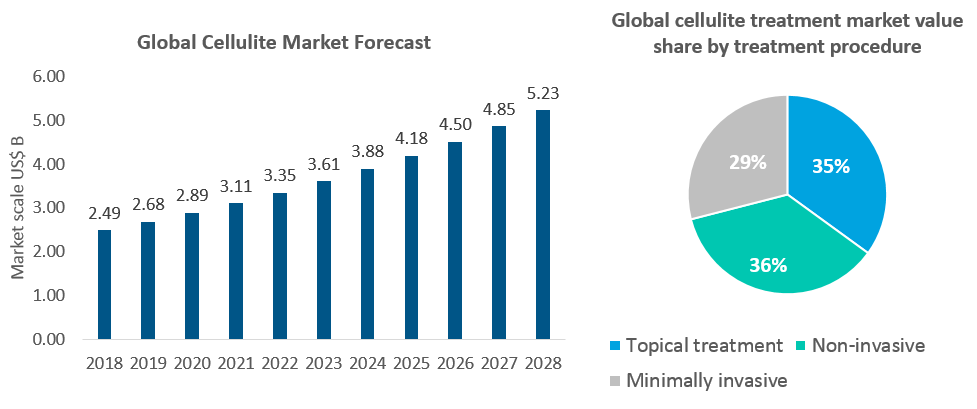

CBL-514 Injection
CBL-514 Market value
US$130B2030 Global local fat reduction
market
2030 Global Dercum’s disease market
2030 Global cellulite treatment market
- First-in-class lipolysis injection that can induce fat cell apoptosis without causing necrosis or damage to other tissues or cells.
- The efficacy is significant and can be observed within 2 weeks.
- On average of 25% (around 120 mL) of the treated area fat can be reduced. 50% of fat can be reduced at most. The curative effect is better than other non-surgical products.
- The drug is safe and well tolerated, with mild side effects, no sequelae or systemic side effects.
- The world's only local fat reduction injection that can be used in a large treatment area such as abdomen and thighs.
Indications
- Non-Surgical Fat Reduction
- Dercum’s Disease
- Cellulite
- Lipoma
Stage
Non-Surgical Fat Reduction
Market Overview

According to the 2021 Deloitte China Body Sculpting Market Industry Development White Paper, China’s local fat reduction and body sculpting medical aesthetic market, including invasive and non-invasive medical treatments, will exceed US$1.5 billion in 2020 and have a CAGR of 25%. It is estimated that by 2030 China market will reach US$15.4 billion, and the global market will reach US$42 billion in 2026, and US$102.5 billion in 2030.
Introduction to Body Fat Reduction Treatments
According to the latest survey data from 2020 American Society for Dermatologic Surgery (ASDS), the number of consumers receiving body sculpting treatment in 2019 increased by 60%, compared with the previous year, and among them, the number of those who sought non‐invasive treatment increased by about 47%. Moreover, American Society for Aesthetic Plastic Surgery (ASAPS) indicates that the number of invasive and non-invasive lipolysis treatments performed in the US increased respectively by -0.4% and 8.2%, compared with 2019. This shows the trend that consumers are gradually turning to non-invasive local fat reduction treatments.
The current subcutaneous fat reduction procedures include invasive surgery, such as liposuction and abdominoplasty, and non-invasive products. Studies have shown that liposuction can remove an average of 183.3mL of abdomen fat, yet it involves a lengthy procedure that is generally performed in an operating room and may also carry the risk of unfavorable outcomes and moderate to severe side effects. The efficacy of non-invasive procedures is generally less optimal with limited treatment areas and potential side effects, including tissue necrosis, nerve damage, and paradoxical adipose hyperplasia (PAH).
According to the American Society of Plastic Surgeons’ report, more than 60% of people are reluctant to undergo subcutaneous fat reduction procedures due to the fear of the side effects. The medical needs for subcutaneous fat reduction remain unmet.
R&D Progress
CBL-514 injection is a first-in-class innovative small molecule drug in medical aesthetics, which can induce adipocyte apoptosis to reduce local fat at the treated area accurately without causing necrosis or damage to other tissue cells.
The Phase IIa study of CBL-514 injection for non-surgical fat reduction was completed in November 2020. The study results demonstrated that CBL-514 could significantly reduce the subcutaneous fat at the treatment site. The study met all the primary and secondary efficacy endpoints (p<0.00001) and showed CBL-514 good safety and tolerance profiles.
The U.S. FDA-approved Phase II study for non-surgical fat reduction was completed in March 2023, and the study met all the primary and secondary endpoints. The study results demonstrated that 69.9% and 60.9% of participants could lose at least 150mL and 200mL of abdominal subcutaneous fat in the treated area after CBL-514 treatment. Compared with placebo, an average of 312.1mL of subcutaneous fat was reduced in the treated area after CBL-514 treatment. Overall, CBL-514 showed favorable safety and tolerance profiles and were consistent with previous clinical studies of CBL-514. For more information, click here.
Dercum’s Disease
Market Overview
The U.S. market for Dercum's disease in 2019 was approximately US$3.74 billion (approximately one-third of the world), and the global market is estimated to be approximately US$10.9 billion. It is estimated that the global market will reach US$17.7 billion in 2026 with a CAGR value of 7.1%.

Note: The US market value is estimated by the USA prevalence(124,500) * lipoma treatment avg cost (US$2,000)
Introduction to Dercum’s Disease
Dercum’s disease is a rare disease characterized by painful lipomas with abnormal accumulation of subcutaneous fat in some parts of the patient's trunk, accompanied by severe spontaneous pain in this part. The nature of the pain is acupuncture-like or knife-cutting sharp pain, which is paroxysmal or persistent. It is estimated that approximately 200,000 people in the United States suffer from Dercum’s disease. The cause of this sinus root's disease has not yet been determined. Studies have pointed out that it may be related to nervous system dysfunction, mechanical pressure on nerve tissue, and adipose tissue metabolism disorder.
Currently, there is no approved drug for Dercum’s disease; therefore, surgery and analgesics are the major means to relieve symptoms. However, the efficacies of the current treatment are rather poor and temporary. On the other hand, surgical resection and liposuction come with multiple side effects and sequelae; moreover, they often cause lipoma recurrence.
| Existing Therapies | Surgical Excision | Analgesics | Immunomodulators | |
| Target | Lipoma removal, Liposuction | Pain relief | Inhib the effect of certain substances | Pain relief |
| Disadvantage | High postoperative recurrence, multiple wounds, etc. | Temporary pain relief, poor efficacy, severe side effects, etc. | Poor efficacy, unable to cure the disease, severe side effects, etc. | Temporary pain relief, unable to cure the disease etc. |
| Side Effect | Bruising, pain, infection, redness, dimpling at the surgical site, etc. | Apprehension, dizziness, drowsiness, etc. | Headache, tiredness, diarrhea, upset, stomach, infection, hyperhypersensitivity. | Burning and redness at the treatment site |
R&D Progress
CBL-514's indication for treating Dercum's disease is under investigation. The U.S. FDA-approved CBL-0201DD Phase 2 study was completed in April 2023. The study met all the primary and secondary endpoints and demonstrated that CBL-514 is the first and only product to show clinically meaningful and statistically significant in painful lipomas complete clearance or dimensions reduction of more than 50%, and improve pain significantly by 4.7 points. For the complete study results announcement, click here.
The IND of the placebo-controlled CBL-0202DD Phase 2 study has been approved by the U.S. FDA in January 2024, the subject recruitment will be initiated in Q2 2024.
Expanded Access Policy
Currently, CBL-514 is in clinical development stage, which means more clinical studies are required and health authorities have not yet approved the product to be an accredited treatment for Dercum’s Disease.
Caliway encourages clinicians and patients to participate in a clinical trial as the best option for patients to access investigational products. However, we understand that some individuals may not satisfy all the eligibility conditions required to enter a clinical trial, and some may have failed all treatments known to treat their conditions. These patients may receive investigational drug through another option commonly known as “Expanded Access” or “Compassionate Use”.
Generally, Caliway does not provide investigational drugs to patients until there is sufficient data on the safety and efficacy of our products to allow patients and physicians to assess the risks and benefits of using these investigational drugs outside of a clinical trial context. Therefore, after careful consideration, Caliway is not currently offering Expanded Access to CBL-514.
You can find additional information about ongoing clinical trials of CBL-514 on our website and by accessing https://clinicaltrials.gov.
Cellulite
Market Overview
According to the Future Market Insights report, the global cellulite treatment market size was approximately US$2.49 billion in 2018, and it is estimated to reach US$4.5 billion in 2026. According to foreign studies, about 85% of women after puberty have cellulite problems, and with the increase of age and obesity, the probability of obtaining cellulite becomes higher and higher.

Introduction to Cellulite
Cellulite is characterized by the nonpathological appearance of the dimpled skin surface (likened to orange peel, cottage cheese, or mattress appearance), which occurs on the thighs and buttocks. As many as 80 to 90% of women experience cellulite dimpling at some point in their life. The relief alterations of cellulite include depressions and raised areas. The depressions are caused by retraction of the skin by subcutaneous fibrous septa, while raised areas are projections of fat and subcutaneous structures to the skin surface.
The current treatment for cellulite includes non-invasive (medical devices and collagenase-related products) and invasive options. However, their efficacy remains limited as the current treatment options can only treat cellulite temporarily. Additionally, most products would cause significant side effects after administration, including severe bruising, pain, and pigmentation, making most patients reluctant to receive them. The clinical need for cellulite treatment remains unmet.
| Existing Therapies | Non-Invasive Drugs | Non-Invasive Devices | Minimally Invasive Treatments | |
| FDA Approved Indications | Treatment of moderate to severe cellulite | Short-term improvement in the appearance of cellulite | Short-term improvement in the appearance of cellulite | Long-term improvement in the appearance of cellulite |
| Efficacy | 10 weeks after 3 treatments, 6~8% was a two-grade improvement | 10 weeks after treatment, improve the appearance of cellulite | 1 year after treatment, increases 25% in Skin thickness and 29% in skin elasticity | After treatment, results lasting up to 2 years |
| Side Effect | Hypersensitivity, Bruising, Pain, Pruritus, Immunogenicity | Pain, No adverse events were identified as serious or severe | Pain, Redness, Swelling, Bruising, Itching, Blistering, Necrosis | Swelling, Pain, Bruising |
R&D Progress
CBL-514's indication for cellulite treatment is currently under investigation. The Phase II study IND has received U.S. FDA approval in August 2022.


